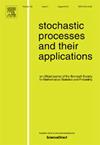具有不连续极限的随机化学反应网络与AIMD过程
IF 1.2
2区 数学
Q3 STATISTICS & PROBABILITY
引用次数: 0
摘要
本文研究了一类随机化学反应网络(crn),其中化学物质是由一系列链式反应产生的。我们证明了在一些方便的初始状态条件下,这些网络中的一些表现出离散诱导跃迁(DIT)性质:孤立的,随机的事件对过程的宏观状态有直接的影响。虽然这一现象已经在一些crn中被注意到,特别是在物理文献中的自催化网络中,但到目前为止,这一领域的严谨研究还很少。对几种具有不同初始状态的crn进行了尺度分析。研究了具有四个节点的CRN的DIT属性。我们证明了在正常时间尺度上,对于(大)初始状态子集和方便的Skorohod拓扑,缩放过程在分布上收敛为具有跳跃的马尔可夫过程,即加法增加/乘法减少(AIMD)过程。这种渐近不连续的极限行为是DIT性质的结果,这是由于在小时间间隔内发生的随机的、局部的、爆炸的跳变。通过对AIMD过程的不变测度和时变参数的显式表示,我们证明了随着时间尺度的加速,尺度过程在分布上收敛为连续的确定性函数。本文分析的DIT性质与三种化学物质之间的简单链式反应有关,因此可能是一大类crn的相当普遍的现象。本文章由计算机程序翻译,如有差异,请以英文原文为准。
Stochastic chemical reaction networks with discontinuous limits and AIMD processes
In this paper we study a class of stochastic chemical reaction networks (CRNs) for which chemical species are created by a sequence of chain reactions. We prove that under some convenient conditions on the initial state, some of these networks exhibit a discrete-induced transitions (DIT) property: isolated, random, events have a direct impact on the macroscopic state of the process. Although this phenomenon has already been noticed in several CRNs, in auto-catalytic networks in the literature of physics in particular, there are up to now few rigorous studies in this domain. A scaling analysis of several cases of such CRNs with several classes of initial states is achieved. The DIT property is investigated for the case of a CRN with four nodes. We show that on the normal timescale and for a subset of (large) initial states and for convenient Skorohod topologies, the scaled process converges in distribution to a Markov process with jumps, an Additive Increase/Multiplicative Decrease (AIMD) process. This asymptotically discontinuous limiting behavior is a consequence of a DIT property due to random, local, blowups of jumps occurring during small time intervals. With an explicit representation of invariant measures of AIMD processes and time-change arguments, we show that, with a speed-up of the timescale, the scaled process is converging in distribution to a continuous deterministic function. The DIT property analyzed in this paper is connected to a simple chain reaction between three chemical species and is therefore likely to be a quite generic phenomenon for a large class of CRNs.
求助全文
通过发布文献求助,成功后即可免费获取论文全文。
去求助
来源期刊

Stochastic Processes and their Applications
数学-统计学与概率论
CiteScore
2.90
自引率
7.10%
发文量
180
审稿时长
23.6 weeks
期刊介绍:
Stochastic Processes and their Applications publishes papers on the theory and applications of stochastic processes. It is concerned with concepts and techniques, and is oriented towards a broad spectrum of mathematical, scientific and engineering interests.
Characterization, structural properties, inference and control of stochastic processes are covered. The journal is exacting and scholarly in its standards. Every effort is made to promote innovation, vitality, and communication between disciplines. All papers are refereed.
 求助内容:
求助内容: 应助结果提醒方式:
应助结果提醒方式:


